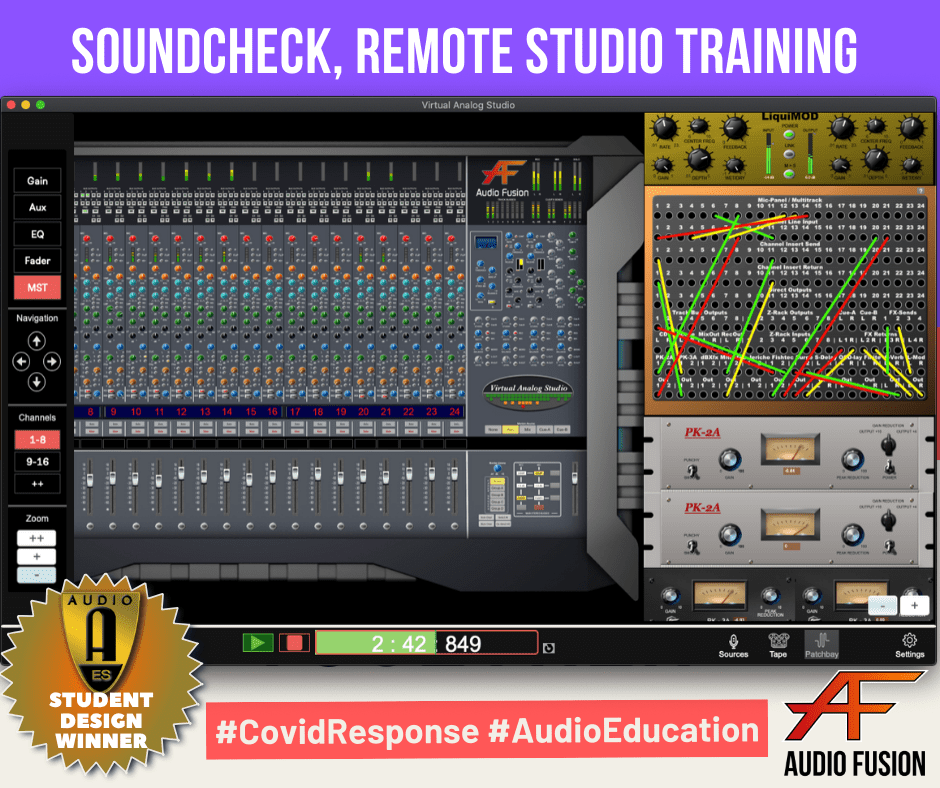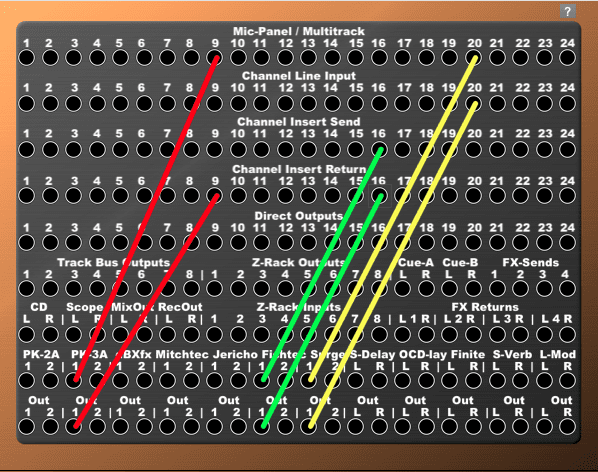
Making the transition to virtual training could make one hesitant. There are many questions and considerations that rightfully need to be examined prior to making the jump. Whether or not you are an educator or student, the idea of virtual in audio technology has been a blackhole of discussions since the dawn of digital. There are arguments about whether or not digital (or virtual) can achieve the same sonic qualities of classic hardware studios. Using SoundcheckPro in a course will change the way students & educators engage.
When it comes to the topics of signal flow & console training, the question of sonic quality is not the primary feature. Rather, it is the functional operation of the software and how well the lesson content can transfer into real experience. The primary focus is functionality.
Does the virtual workflow translate to the real thing? Does it help train aspiring engineers how to approach whatever audio environments they encounter?
In these times of the pandemic, there is another critical question. Can educators teach the studio courses that they are now forced to teach online?
SoundcheckPro is a great solution for remote studio training!
Anyone can start practicing the technical workflows used in studios right now.

Signup for a full access trial – here
Tips to quickly transition your course to virtual:
- Treat the Soundcheck environments like a new studio
- Utilize Soundcheck in Parallel with existing course material
- Start with introductory lessons. reinforce the basics, expand to advanced
- Follow our lesson plans – here
- Watch the Youtube Videos – here
- Explore our growing Support Base – here
- Read more articles like this on the blog – here
Treat the Soundcheck environments like its a new studio

Soundcheck offers a multiple variety of console environments that changes up the workflow experience. There may be an immediate reaction that makes one wish the studio can resemble their physical studios but, that is not the recommended approach. Regardless of any studio in the world, an experienced engineer should be able to discover what’s going on in the signal flow of the environment. That said, it’s crucial to gain the deepest understanding of Soundchecks current environments.
A signal flow document is continually being updated to help visualize Soundcheck’s setup.
Utilize Soundcheck in Parallel with existing course material
The educators that have had the most success with implementing Soundcheck are those who recognize that they can use Soundcheck in parallel with what they already teach. After looking over their existing course structure and demonstrating Soundcheck when applicable they were effectively able to draft their curriculum structure.
There is also a great idea for mixing classes to demonstrate tips in a classic DAW then demonstrate the workflow in Soundcheck’s console workflow. This enables students to remain “DAW-agnostic” in their skill building as they’re constantly aware of the difference of how they would work in different domains.

Start with introductory lessons. reinforce the basics, expand to advanced
If Soundcheck is a new studio, then it needs some attention under the hood to be understood. Getting to that point requires an understanding of the basic workflow and common studio techniques available. Not just for the teacher but the students.
Drill down the basics then switch things up with troubleshooting exercises.
For many programs there are long durations (months) between recording classes. This is a period of time students are vulnerable to forget key concepts to what they’ve learned. When the next studio class arrives, educators need to re-teach material students already learned as a refresher. With Soundcheck students can practice exercises prior to the next recording class start date. Educators will then be able to teach advanced content on day one rather than refreshing.
Follow Our Lesson Plans
To assist educators who may be newer to pro audio education, we offer a series of lesson-plans to help design a curriculum. These documents are freely available on our website (here). The lessons are not “Soundcheck dependent” in that they are designed more for course discussions and readings for the educator to communicate. Once everyone has an understanding of the lesson content could exercises be performed in Soundcheck.

Check out the freely available lesson plans – Here
Have an idea for a lesson plan? Get in touch with us – Here
Follow the Youtube Videos
Having an audio/visual guide will offer deeper insight into the environment. Follow a video series developed by our Education Officer, Anthony Schultz, while he demonstrates the basics of working with signal flow & consoles in Soundcheck. Anthony is an educator and studio owner of over 25 years experience. Stay tuned for a fresh new series showing deeper secrets in Soundcheck!

Watch the Youtube Videos – Here
Explore our growing Support Base
The online documentation for Soundcheck is found in our Support Base. Tutorials, How To’s and deeper explanations of the features found throughout Soundcheck. Topics are divided into categories and could also be searched at the main Support Base page. A growing glossary will also be a sub-feature of the support base that enables users to search terms or click on highlighted text from the articles.
Explore our growing Support Base – Here
Read More Articles On the Blog
What makes the studio so unique is how differently it is used by everyone. Follow the blog for education content that we share from our experiences and content written by our partners in education.
Read more articles like this on the blog – Here